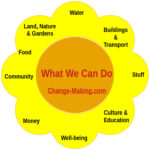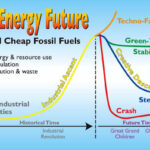What might it look like?
What it won’t be
If we wait for the governments, it’ll be too little, too late
If we act as individuals, it’ll be too little
But if we act as communities, it might just be enough,
just in time.
– Transition movement, Cheerful Disclaimer
The Transition movement understands, at an intuitive level, that government cannot fix it. We won’t be seeing large-scale, meaningful, sufficient problem-solving action — on global warming, environmental toxins, peak oil, social justice — from our government agencies, certainly not within the timeframe in which we need to see action. We understand this about tangible things like food, transportation, water. It is important to acknowledge that we won’t be seeing sufficient, meaningful action on economics or political reform either.
James Gustave Speth offers a very specific analysis of why this is so. On [page reference], I shared the quote from Peter Barnes about the self‑serving relationship between our current form of capitalism and our current form of democracy. Speth offers detail after detail of how the present system is flawed at a very basic level. These include
- corporate personhood, that the law grants a corporations the rights of a human being;
- limited liability, that corporate officers cannot be held liable, thus they cannot be held accountable;
- shareholder primacy, that the primary duty of corporate officers is to look after shareholder profits, which trump even moral and environmental concerns;
- externalization of costs, that the true costs to the community, humanity, and the planet don’t have to be weighed in decision-making;
- corporations in politics, with the ability to influence everything from elections to policy and legislation.
- (The list continues, and for full explanation, please read Speth’s book.)
Add to this Thom Hartmann’s list of how the present system is flawed:
- political dominance, hierarchical/clear authority structures, get their resources through trade and conquest, absorb other cultures into their own identity, genocidal warfare against others
Reversing these isn’t a matter of making some “tweaks” to our existing political-economic system. These fixes represent a radical departure from how our current system has defined itself. In computer programmer’s terms, this isn’t a bug repair. This is a rebuild.
If one listens to Stoneleigh, Jared Diamond, Richard Heinberg and James Howard Kunsler, we are soon likely to have opportunity for that rebuild. But Hopkins and the Transition movement are working to assure that safety nets are in place, so that things going “bad” doesn’t have to become “unsurvivable” as we navigate through this period of massive, all-encompassing, transformative change.
It really comes back to us, the grassroots citizenry, to craft the real solutions that will make a better world.
Elements to uphold
Speth tells us what is wrong with the current political-economic system, and gives us a few slight clues as to the undoing of it. For the rest, we must turn his lists of “what is wrong” inside out, and use these elements as we create our local safety net.
Speth recommends “neighborhood associations,” which in my view basically translates to empowering the citizenry. Within the Transition movement, we already are doing this. We’re creating local community groups which are getting down to work, setting up “emergency care,” massaging the elements of the future economy into local functionality, and doing the preliminary work of observing and brainstorming to create the new structures for what is to come.
Turning Speth’s “what is wrong” inside-out, we discover new elements which we will need to uphold within our local community groups. We will need to adhere to these in order to avoid the mistake of replicating the flaws of the old structure in what we create anew.
Personhood. Within our community groups, corporations shouldn’t be granted the same standing as human beings. Humans are persons, and corporations are not people. The tiny city of Arcata, California has apparently formally acknowledged this; perhaps our T.I.s should too. Humans are entitled to the full assortment of rights that come with the U.S. Bill of Rights, the U.N. Universal Declaration of Human Rights, the Earth Charter preamble and similar documents, and the rights of human beings supersede any claims of corporate “rights.” Within our Transition circles and our immediate community, we must remember to uphold this crucial departure from business-as-usual ways.
Responsibility and trust. In the mainstream world, executives are able to hide bad decisions behind corporate protections, corporate entities and limited liability. History has proven that these “protections” erode the sense of responsibility to the community and to fellow human beings. Within the communities of the future, we will need to return to people being accountable for their decisions. People should act within good faith and the best of their ability, to uphold such concepts as the Rights of others. Within our small Transition circles, we cultivate an atmosphere of responsibility and trust, such that these become moot issues. At present within our fledgling community groups, this may seem like an absurd issue to mention, but as our safety nets become the new structures for the wider community, we must already have this root-level concept in place.
Public politics. Already within our Transition initiatives, we are creating a very different culture of how people work together. With circle techniques, shifting leadership, Open Space, World Café, fishbowl events, and more, we are creating a “political” environment that includes transparency and equal voice for all. Human beings have a voice within this movement; corporations do not. In our Transition fishbowl circles, we consider the voice of fellow community members — fellow human beings — rather than the biggest corporation in town. In our vision plans and EDAPs, corporations can’t buy the results they want to see.
It will become important to remember this early culture, and the ways in which it is a radical departure from the mainstream way of doing things. As our community groups grow and gain new form, it is important to not relinquish these ideas — for instance altering our group’s form, approach, process, or mission in order to gain grant money.
We must be very careful about this as we embrace other organizations as partners. Perhaps that is why, in the new Transition Companion, Hopkins et al are qualifying the phrases “strategic partnerships” and “supportive partnerships.” In other words, we must carefully select partners who are supportive of the same mission, approach and process.
Errant direction can happen rather innocuously: A large “green” vendor asks for a table at your Transition event to sell their product. Their presence at your event will be perceived by the public as your T.I.’s endorsement of whatever they are selling. Thus vetting becomes important — is this company on board the trio of crises? Are you working toward the same general agenda? Or are they simply a green-cast way of perpetuating opulent consumerism? Are you so eager to fill your event with tables that you will take all comers? Or are you sticking up for the basic premises of our Transition initiatives’ reason for being: creating the new structures that will enable energy descent, and – despite peak oil, climate change, and biocapacity — provide a livable future for all.
Identity. Hartmann reminds us to uphold that unique sense of our own identity. Our Transition initiatives, even very early ones, have a unique identity within this society: We are the ones who are concerned about the trio of crises, and who use this concern as a driver for building new structures. The primary duty of our T.I. is to that mission. As the Transition process deepens, and more people and organizations get on board, we will continue to have a unique identity: as vision-holder, keeping track of the road ahead.
That identity is what will keep your T.I. on track when the easy temptation of business-as-usual might take you on a wild goose chase. It is important to embrace this unique identity – to craft it into your founding documents, and to revisit this unique identity from time to time within your steering group or core team, to remind each other of who you are and what this group represents.
Hartmann also reminds us about respecting the unique identity of others. In the case of our TI.s that might mean other nearby T.I.s, or (taking Practical Tool #9 into serious consideration) respecting the unique culture and voice of groups which the industrial-growth-paradigm-world discounted or overpowered.
Renewable local sources. “Renewable resources” has become a glib phrase tossed around in the vernacular with little connection to what it means.
David Holmgren stated (Santa Barbara, 2005) that in the future the symbol of “solar power” won’t be a PV panel, with its myriad of trace elements, plastics, delicate electronics, and global supply chain. Instead, the symbol of “solar power” will be a tree.
Eventually we must evolve to a model that defines “renewable local resources” with cradle-to-cradle criteria: How local is the source of the plastics and metals of those PV panels? What is the environmental impact of their extraction and eventual disposition? How is the global supply of the trace elements? What is the carbon footprint and embodied petroleum cost of their manufacture and distribution? Is the solar power thus derived made available to all on a fair and just basis? And is the expected volume of production in keeping with one-planet’s-worth-of-consumption?
As we build the new paradigm local economies, this long-term view must be in the backs of our minds. As we select movies and speakers for awareness-raising events, as we do outreach, as we set up the tools of the new economy, we carry this understanding.
Yes, it may get panned as a “hard-liner” view. But really it’s the laws of physics on this one small planet that are the true hard-liner. Our T.I.s are just the messengers, reminding people of what our culture has so conveniently tried to forget.
What might it look like?
When we’re analyzing potential scenarios for the future – for economics or for anything else – it’s important to distinguish the end goal versus the journey.
Perhaps it’s easier to see with a different topic. We can all agree that our current food system — now — with globalized supply chain, massive petrochemical inputs, subsidy system, processing, food deserts, etc. is unsustainable. In the future, many of us agree that the predominance of our food will come from local sources, that it will needs be organic, that processing will be vastly reduced. The journey from now to then will mean a long series of concrete steps that take us toward that goal — things like supporting existing local farmers economically, furthering urban agriculture, building more community gardens, etc.
In economics, many, many thinkers wish to tell us what is wrong with now and warn about what is going to happen to the present system (Heinberg, Stoneleigh). Several thinkers offer visions for the end goal, the future, what it might be like when we get there (Daly Steady State; Eisenstein gift culture; Hartmann Older Culture).
Some offer visions for how the journey from here to there might unfold. Of these, many convey their dreams for what the government might do (Speth, Daly, NEF text, Eisenstein’s “roadmap”). A select few offer concrete tools that can be used by the people to further this change (summarized in Practical Tools #1 through 9). We have to select our tools based on whether they will get us where we want to go.
“The Shadow Structure,” then, is the background understanding of where we want to go, and the rudimentary framework that will begin to take us there. On p. {x} is an early, early stage example, using Hartmann’s characteristics as the end goal.


